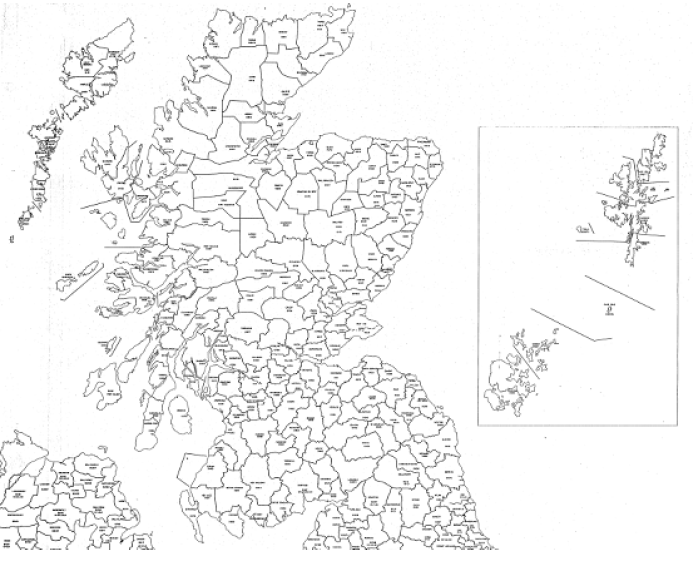Effectiveness of actions to reduce harm from nuisance calls in Scotland
Research commissioned to analyse the impact of actions set out in the Nuisance Calls Commission action plan, and to examine the outcomes of past interventions.
Annex L: Telephone area codes and local authority areas in Scotland
L.1 Telephone area codes
Figure 77 (originally provided by BT) is more than twenty years old; it is included only to give an idea of the complexity of the Scottish landline telephone system. It shows the rough coverage of each of the telephone area codes. With network competition, area code boundaries are less clearly defined: close neighbours using different operators may have landline numbers with different area codes. Indeed, several among the ranges of telephone numbers in such telephone areas as ‘0131’ (Edinburgh) and ‘0141’ (Glasgow) are allocated to an operator other than BT and used throughout various adjoining council areas. The porting of numbers between operators is likely to have muddled the ranges further.
Each telephone area might cover parts of several council areas though it has its main switching centre in one of them. This is so for both urban centres and rural districts. Consequently the numbers of inhabitants (and numbers of TPS registrations) vary greatly between telephone areas: ‘0141’ has about 10,000 times as many as ‘01951’ (Colonsay).
Figure 77: Telephone area codes in Scotland

L.2 TPS and census data
TPS identifies telephone numbers and therefore telephone area codes, so we know the number of TPS registrations in each telephone area. For this purpose we have used 2017 figures. However, operators do not always notify TPS when service stops on a telephone number, so TPS figures probably include some telephone numbers that are no longer active, and the register could contain other discrepancies [152] .
The household figures that we use in assessing TPS registration density are the 2016 estimates of “occupied dwellings” [153] . While most households have a single landline, a growing proportion has none and a small proportion has more than one.
L.3 The mapping
As the basis for the mapping we have used the 2011 census intermediate zones. These also vary in size, but less extremely than telephone areas: the smallest has 1,314 inhabitants and the largest has 11,754, but the sizes of many of them are quite well clustered around the mean (4,395) and the median (4,083).
An intermediate zone lies within a single council area but does not necessarily lie within a single telephone area [154] . Where an Intermediate zone lies in multiple telephone areas, we have divided its number of households equally between those telephone areas, and we have assumed, as a starting point for the algorithm, that for each of those telephone areas its number of TPS registrations is proportional to the number of TPS registrations in Scotland as a whole [155] . Local knowledge of the telephone numbers in particular intermediate zones could refine this division, and postcode information from TPS (where available) would greatly simplify the mapping task.
We have no reason to suppose that the figure for Eilean Siar is wrong, despite its contrast with the figures for Argyll & Bute, Orkney Islands and Shetland Islands: though all of these council areas might be suited to distance sales, Gaelic is used in 40% of homes in Eilean Siar but at most 1% in these other council areas.
The algorithm relies on matching place names associated with ranges of telephone numbers to place names associated with localities, settlements and intermediate zones [156] . Some names are used in more than one intermediate zone in the source data; they have been changed slightly to eliminate mismatches.
Contact
There is a problem
Thanks for your feedback